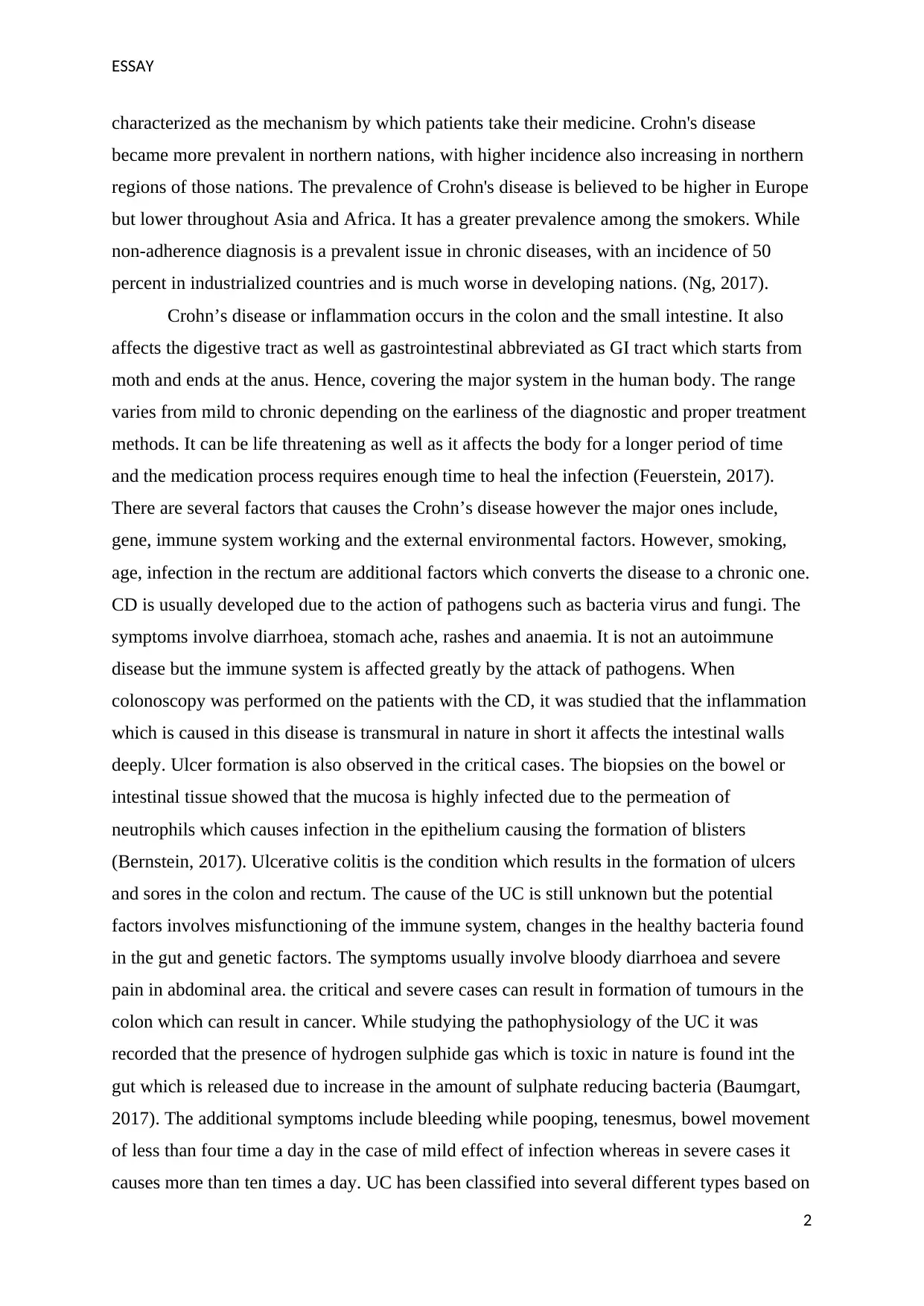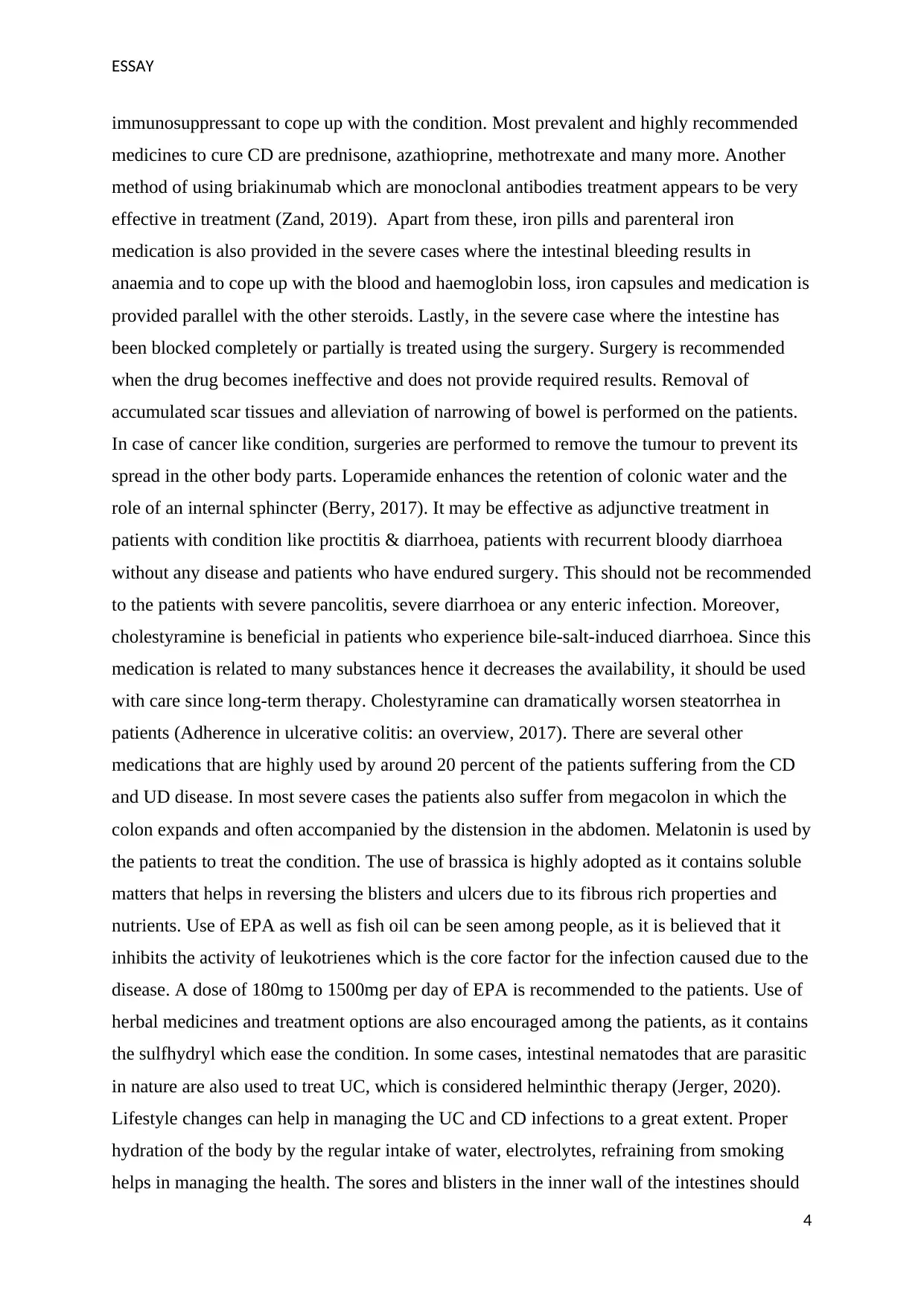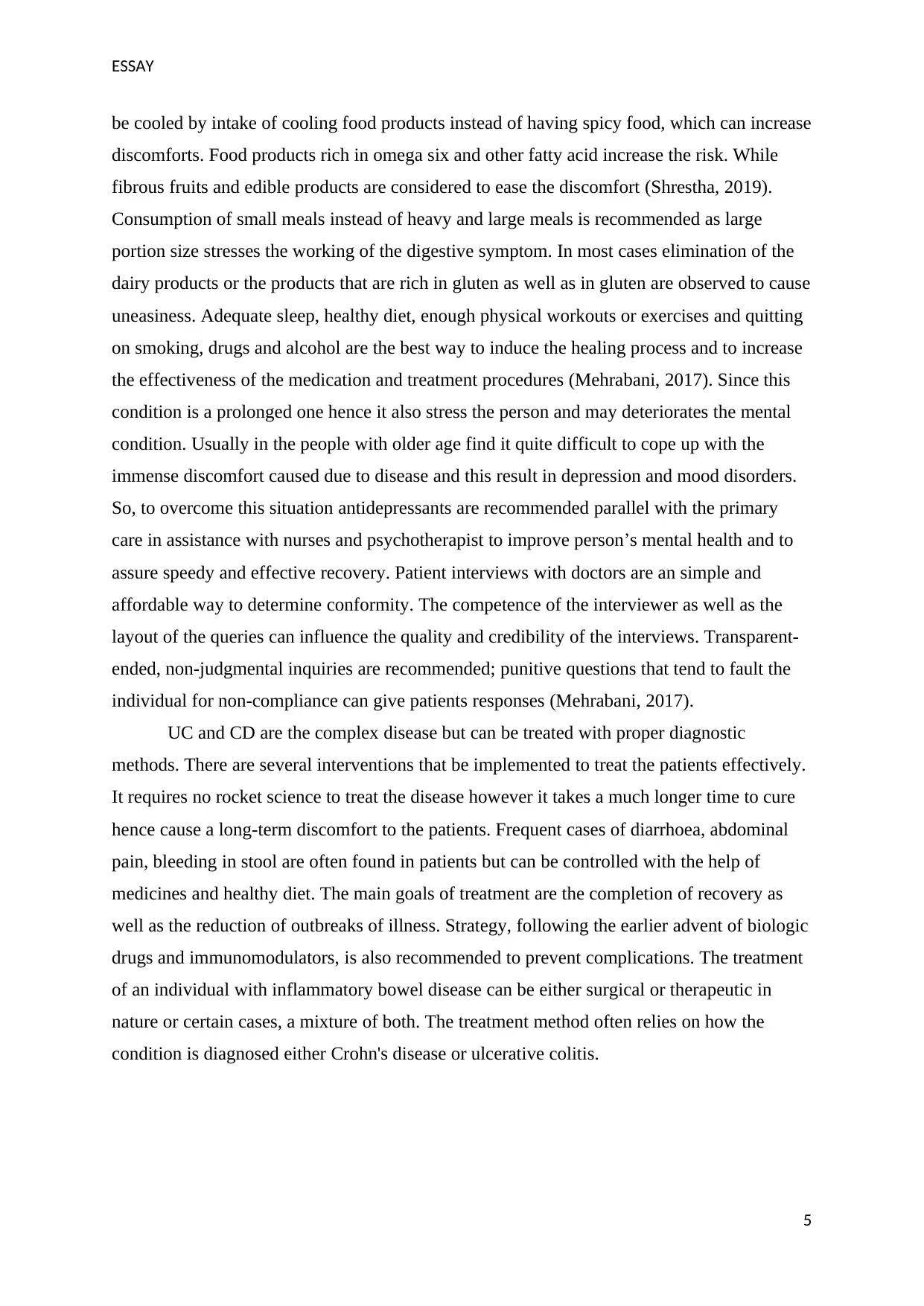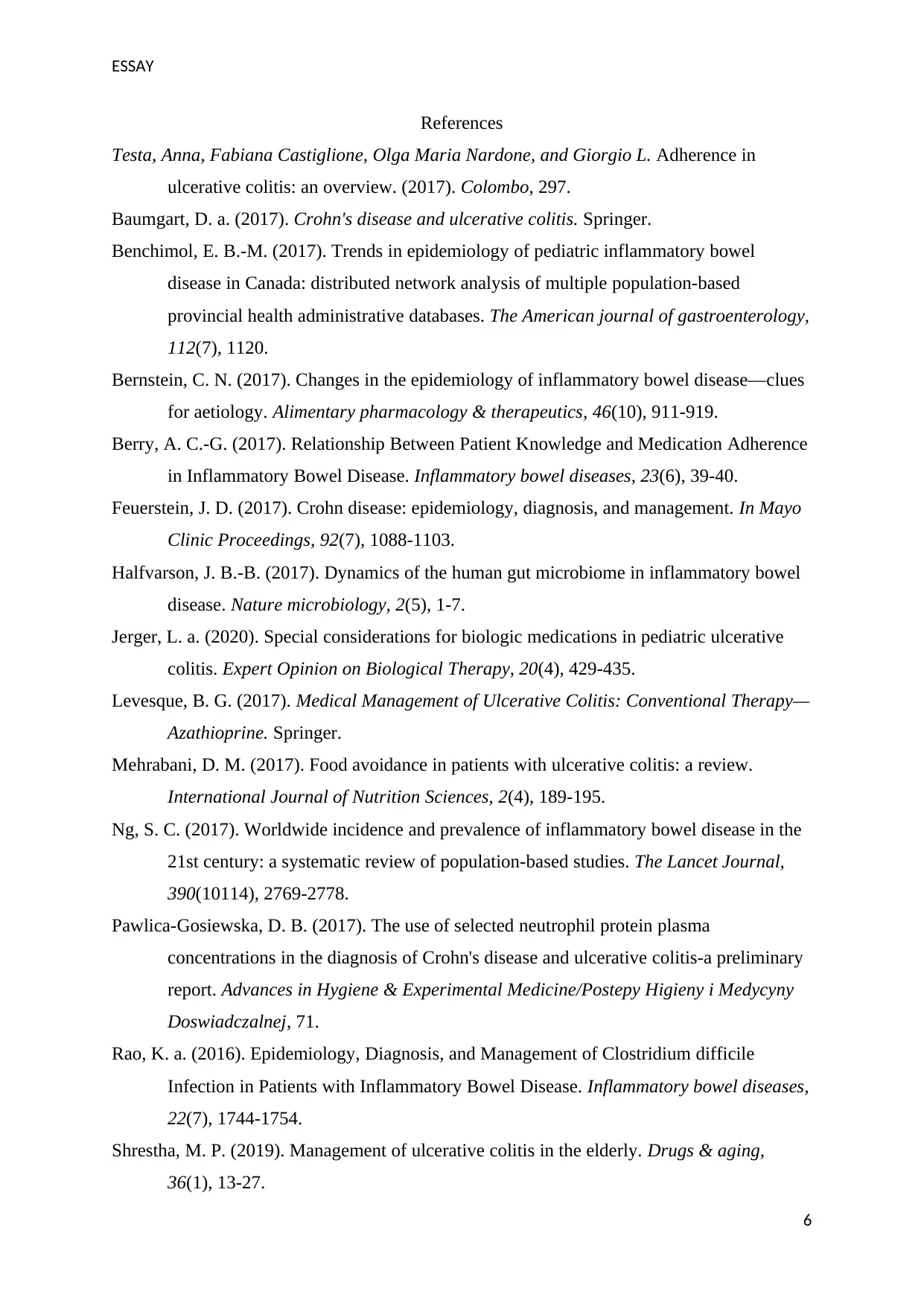Essay - Bowel Diseases | Assignment
VerifiedAdded on 2022/09/06
|8
|2986
|20
AI Summary
Contribute Materials
Your contribution can guide someone’s learning journey. Share your
documents today.

ESSAY
0
0
Secure Best Marks with AI Grader
Need help grading? Try our AI Grader for instant feedback on your assignments.

ESSAY
Bowel disease usually involves two major disease named as Crohn’s disease and
Ulcerative colitis which occurs due to inflammation or infection in the digestive tract,
intestine and anus. These diseases are type of long lasting and involves prolonged
deterioration in the condition of the person (Halfvarson, 2017). This discussion focuses on
the different aspects related to the CD and UC such as their pathophysiology, aetiology and
anatomy to get the better understanding about the disease from the view of the scientific
researches. It gives the data about the prevalence of these diseases across the globe. It
explains how the lower gastrointestinal tract is affected due to the infection. It also discusses
about the diagnostic methods that can be used to detect the infection and further
acknowledgment with the several different treatment interventions that can be incorporated in
the plans to treat the patients with the bowel diseases.
It has been studied that the prevalence of the bowel disease is quite common and
global. There are several studies that has been conducted to observe the impact of the bowel
dieses on different set of population across the world. In a similar study it was recorded that
the Europe and North America has most cases with 0.5 percent in Norway followed by the
0.3 percent in Germany and 0.28 percent in USA and 0.31 percent in Canada. Nova Scotia in
Canada has been recorded to have the highest number of patients (Benchimol, 2017). It has
been found out that the second-generation immigrant is at higher risk of getting disease then
the first generations immigrants. A study based on population showed that the immigrant
from South Asia had lower incidences of bowel disease. According to the CCF in America it
has been noted that there are around 7 lakhs cases on inflammatory bowel disease. The
infected patients usually fall in the age of group of 13 to 18 years and is often diagnosed in
the childhood or adolescence. Adherence to treatments and medications prescribed by the
doctors i s
1
Bowel Diseases
CD and UC
4-1-2020
Bowel disease usually involves two major disease named as Crohn’s disease and
Ulcerative colitis which occurs due to inflammation or infection in the digestive tract,
intestine and anus. These diseases are type of long lasting and involves prolonged
deterioration in the condition of the person (Halfvarson, 2017). This discussion focuses on
the different aspects related to the CD and UC such as their pathophysiology, aetiology and
anatomy to get the better understanding about the disease from the view of the scientific
researches. It gives the data about the prevalence of these diseases across the globe. It
explains how the lower gastrointestinal tract is affected due to the infection. It also discusses
about the diagnostic methods that can be used to detect the infection and further
acknowledgment with the several different treatment interventions that can be incorporated in
the plans to treat the patients with the bowel diseases.
It has been studied that the prevalence of the bowel disease is quite common and
global. There are several studies that has been conducted to observe the impact of the bowel
dieses on different set of population across the world. In a similar study it was recorded that
the Europe and North America has most cases with 0.5 percent in Norway followed by the
0.3 percent in Germany and 0.28 percent in USA and 0.31 percent in Canada. Nova Scotia in
Canada has been recorded to have the highest number of patients (Benchimol, 2017). It has
been found out that the second-generation immigrant is at higher risk of getting disease then
the first generations immigrants. A study based on population showed that the immigrant
from South Asia had lower incidences of bowel disease. According to the CCF in America it
has been noted that there are around 7 lakhs cases on inflammatory bowel disease. The
infected patients usually fall in the age of group of 13 to 18 years and is often diagnosed in
the childhood or adolescence. Adherence to treatments and medications prescribed by the
doctors i s
1
Bowel Diseases
CD and UC
4-1-2020

ESSAY
characterized as the mechanism by which patients take their medicine. Crohn's disease
became more prevalent in northern nations, with higher incidence also increasing in northern
regions of those nations. The prevalence of Crohn's disease is believed to be higher in Europe
but lower throughout Asia and Africa. It has a greater prevalence among the smokers. While
non-adherence diagnosis is a prevalent issue in chronic diseases, with an incidence of 50
percent in industrialized countries and is much worse in developing nations. (Ng, 2017).
Crohn’s disease or inflammation occurs in the colon and the small intestine. It also
affects the digestive tract as well as gastrointestinal abbreviated as GI tract which starts from
moth and ends at the anus. Hence, covering the major system in the human body. The range
varies from mild to chronic depending on the earliness of the diagnostic and proper treatment
methods. It can be life threatening as well as it affects the body for a longer period of time
and the medication process requires enough time to heal the infection (Feuerstein, 2017).
There are several factors that causes the Crohn’s disease however the major ones include,
gene, immune system working and the external environmental factors. However, smoking,
age, infection in the rectum are additional factors which converts the disease to a chronic one.
CD is usually developed due to the action of pathogens such as bacteria virus and fungi. The
symptoms involve diarrhoea, stomach ache, rashes and anaemia. It is not an autoimmune
disease but the immune system is affected greatly by the attack of pathogens. When
colonoscopy was performed on the patients with the CD, it was studied that the inflammation
which is caused in this disease is transmural in nature in short it affects the intestinal walls
deeply. Ulcer formation is also observed in the critical cases. The biopsies on the bowel or
intestinal tissue showed that the mucosa is highly infected due to the permeation of
neutrophils which causes infection in the epithelium causing the formation of blisters
(Bernstein, 2017). Ulcerative colitis is the condition which results in the formation of ulcers
and sores in the colon and rectum. The cause of the UC is still unknown but the potential
factors involves misfunctioning of the immune system, changes in the healthy bacteria found
in the gut and genetic factors. The symptoms usually involve bloody diarrhoea and severe
pain in abdominal area. the critical and severe cases can result in formation of tumours in the
colon which can result in cancer. While studying the pathophysiology of the UC it was
recorded that the presence of hydrogen sulphide gas which is toxic in nature is found int the
gut which is released due to increase in the amount of sulphate reducing bacteria (Baumgart,
2017). The additional symptoms include bleeding while pooping, tenesmus, bowel movement
of less than four time a day in the case of mild effect of infection whereas in severe cases it
causes more than ten times a day. UC has been classified into several different types based on
2
characterized as the mechanism by which patients take their medicine. Crohn's disease
became more prevalent in northern nations, with higher incidence also increasing in northern
regions of those nations. The prevalence of Crohn's disease is believed to be higher in Europe
but lower throughout Asia and Africa. It has a greater prevalence among the smokers. While
non-adherence diagnosis is a prevalent issue in chronic diseases, with an incidence of 50
percent in industrialized countries and is much worse in developing nations. (Ng, 2017).
Crohn’s disease or inflammation occurs in the colon and the small intestine. It also
affects the digestive tract as well as gastrointestinal abbreviated as GI tract which starts from
moth and ends at the anus. Hence, covering the major system in the human body. The range
varies from mild to chronic depending on the earliness of the diagnostic and proper treatment
methods. It can be life threatening as well as it affects the body for a longer period of time
and the medication process requires enough time to heal the infection (Feuerstein, 2017).
There are several factors that causes the Crohn’s disease however the major ones include,
gene, immune system working and the external environmental factors. However, smoking,
age, infection in the rectum are additional factors which converts the disease to a chronic one.
CD is usually developed due to the action of pathogens such as bacteria virus and fungi. The
symptoms involve diarrhoea, stomach ache, rashes and anaemia. It is not an autoimmune
disease but the immune system is affected greatly by the attack of pathogens. When
colonoscopy was performed on the patients with the CD, it was studied that the inflammation
which is caused in this disease is transmural in nature in short it affects the intestinal walls
deeply. Ulcer formation is also observed in the critical cases. The biopsies on the bowel or
intestinal tissue showed that the mucosa is highly infected due to the permeation of
neutrophils which causes infection in the epithelium causing the formation of blisters
(Bernstein, 2017). Ulcerative colitis is the condition which results in the formation of ulcers
and sores in the colon and rectum. The cause of the UC is still unknown but the potential
factors involves misfunctioning of the immune system, changes in the healthy bacteria found
in the gut and genetic factors. The symptoms usually involve bloody diarrhoea and severe
pain in abdominal area. the critical and severe cases can result in formation of tumours in the
colon which can result in cancer. While studying the pathophysiology of the UC it was
recorded that the presence of hydrogen sulphide gas which is toxic in nature is found int the
gut which is released due to increase in the amount of sulphate reducing bacteria (Baumgart,
2017). The additional symptoms include bleeding while pooping, tenesmus, bowel movement
of less than four time a day in the case of mild effect of infection whereas in severe cases it
causes more than ten times a day. UC has been classified into several different types based on
2

ESSAY
the location of the infection in the tract. Ulcerative proctitis is termed when the infection
occurs only in the area near to anus or rectum which cause the bleeding in the bowels.
Proctosigmoiditis is the condition when the inflammation is only in the lower part of the
colon involving rectum and sigmoid. Left sided colitis is termed when the infection occurs in
the descending as well as sigmoid part of colon. Pancolitis affects the whole colon including
all four parts. In humans, the large intestine or colon is a part of the lower gastrointestinal
tract or digestive tract. The large intestine has a size of around 5 feet and is plays a vital role
in processing of the food that have already been digested effectively by the body and the
nutrients has been extracted out of the food and is further left for excretion. Large intestine is
divided into four segments and the process of water, electrolyte and vitamin absorption from
the food takes place here. Additionally, it also forms the faecal matter from the undigested
food and forward it to the rectum (Levesque, 2017).
Diagnostic processes of CD and UC are challenging and complex as it involves a
large number of tests to look for the presence of disease. The most important process involves
colonoscopy which is up to 70 percent effective in diagnosis. With advancements in medical
technology, use of capsule endoscopy is highly used which helps in getting the clear
information about the disease present in the lower GI tract since the traditional method does
not provide distinct results. Symptoms such as ulcers, lesions can be easily observed and
studied. Parallel with that blood test to look for the anaemia and infection is performed while
stool test to look for the parasitic attack. This provides with the base to other findings and
research. Imagining test such as Xray, CT scan helps in deducing the condition of the tract as
it clearly identifies the presence of ulcers, or tumours in some case of CD and UC (Rao,
2016). Moreover, pregnant women can bear the child in the UC and CD condition as they do
not hinder with childbirth. However, it must be kept in mind to avoid the use of x-rays and
other radio imagining process to diagnose the disease Additionally, biopsies are crucial to
identify the intensity of infection on the tissues and organs in the GI tract. However,
additional tests are performed in the case of UC to record the exact location of the infection
as it can infect the tract in four different ways with varying intensity and severity. Electrolyte
testing is carried out to parallel with the test to study kidney functioning. Urinalysis and
sigmoidoscopy are other methods to look for specific location of infection by recording the
location of hindrance in the normal mechanism of organs (Pawlica-Gosiewska, 2017).
UC and CD in the acute case involves the medication of antibiotics which helps to
ease the infection such as corticosteroid and amino salicylate-based drug medication. They
can also result in side effects hence prolonged use is avoided. In most cases patients require
3
the location of the infection in the tract. Ulcerative proctitis is termed when the infection
occurs only in the area near to anus or rectum which cause the bleeding in the bowels.
Proctosigmoiditis is the condition when the inflammation is only in the lower part of the
colon involving rectum and sigmoid. Left sided colitis is termed when the infection occurs in
the descending as well as sigmoid part of colon. Pancolitis affects the whole colon including
all four parts. In humans, the large intestine or colon is a part of the lower gastrointestinal
tract or digestive tract. The large intestine has a size of around 5 feet and is plays a vital role
in processing of the food that have already been digested effectively by the body and the
nutrients has been extracted out of the food and is further left for excretion. Large intestine is
divided into four segments and the process of water, electrolyte and vitamin absorption from
the food takes place here. Additionally, it also forms the faecal matter from the undigested
food and forward it to the rectum (Levesque, 2017).
Diagnostic processes of CD and UC are challenging and complex as it involves a
large number of tests to look for the presence of disease. The most important process involves
colonoscopy which is up to 70 percent effective in diagnosis. With advancements in medical
technology, use of capsule endoscopy is highly used which helps in getting the clear
information about the disease present in the lower GI tract since the traditional method does
not provide distinct results. Symptoms such as ulcers, lesions can be easily observed and
studied. Parallel with that blood test to look for the anaemia and infection is performed while
stool test to look for the parasitic attack. This provides with the base to other findings and
research. Imagining test such as Xray, CT scan helps in deducing the condition of the tract as
it clearly identifies the presence of ulcers, or tumours in some case of CD and UC (Rao,
2016). Moreover, pregnant women can bear the child in the UC and CD condition as they do
not hinder with childbirth. However, it must be kept in mind to avoid the use of x-rays and
other radio imagining process to diagnose the disease Additionally, biopsies are crucial to
identify the intensity of infection on the tissues and organs in the GI tract. However,
additional tests are performed in the case of UC to record the exact location of the infection
as it can infect the tract in four different ways with varying intensity and severity. Electrolyte
testing is carried out to parallel with the test to study kidney functioning. Urinalysis and
sigmoidoscopy are other methods to look for specific location of infection by recording the
location of hindrance in the normal mechanism of organs (Pawlica-Gosiewska, 2017).
UC and CD in the acute case involves the medication of antibiotics which helps to
ease the infection such as corticosteroid and amino salicylate-based drug medication. They
can also result in side effects hence prolonged use is avoided. In most cases patients require
3
Secure Best Marks with AI Grader
Need help grading? Try our AI Grader for instant feedback on your assignments.

ESSAY
immunosuppressant to cope up with the condition. Most prevalent and highly recommended
medicines to cure CD are prednisone, azathioprine, methotrexate and many more. Another
method of using briakinumab which are monoclonal antibodies treatment appears to be very
effective in treatment (Zand, 2019). Apart from these, iron pills and parenteral iron
medication is also provided in the severe cases where the intestinal bleeding results in
anaemia and to cope up with the blood and haemoglobin loss, iron capsules and medication is
provided parallel with the other steroids. Lastly, in the severe case where the intestine has
been blocked completely or partially is treated using the surgery. Surgery is recommended
when the drug becomes ineffective and does not provide required results. Removal of
accumulated scar tissues and alleviation of narrowing of bowel is performed on the patients.
In case of cancer like condition, surgeries are performed to remove the tumour to prevent its
spread in the other body parts. Loperamide enhances the retention of colonic water and the
role of an internal sphincter (Berry, 2017). It may be effective as adjunctive treatment in
patients with condition like proctitis & diarrhoea, patients with recurrent bloody diarrhoea
without any disease and patients who have endured surgery. This should not be recommended
to the patients with severe pancolitis, severe diarrhoea or any enteric infection. Moreover,
cholestyramine is beneficial in patients who experience bile-salt-induced diarrhoea. Since this
medication is related to many substances hence it decreases the availability, it should be used
with care since long-term therapy. Cholestyramine can dramatically worsen steatorrhea in
patients (Adherence in ulcerative colitis: an overview, 2017). There are several other
medications that are highly used by around 20 percent of the patients suffering from the CD
and UD disease. In most severe cases the patients also suffer from megacolon in which the
colon expands and often accompanied by the distension in the abdomen. Melatonin is used by
the patients to treat the condition. The use of brassica is highly adopted as it contains soluble
matters that helps in reversing the blisters and ulcers due to its fibrous rich properties and
nutrients. Use of EPA as well as fish oil can be seen among people, as it is believed that it
inhibits the activity of leukotrienes which is the core factor for the infection caused due to the
disease. A dose of 180mg to 1500mg per day of EPA is recommended to the patients. Use of
herbal medicines and treatment options are also encouraged among the patients, as it contains
the sulfhydryl which ease the condition. In some cases, intestinal nematodes that are parasitic
in nature are also used to treat UC, which is considered helminthic therapy (Jerger, 2020).
Lifestyle changes can help in managing the UC and CD infections to a great extent. Proper
hydration of the body by the regular intake of water, electrolytes, refraining from smoking
helps in managing the health. The sores and blisters in the inner wall of the intestines should
4
immunosuppressant to cope up with the condition. Most prevalent and highly recommended
medicines to cure CD are prednisone, azathioprine, methotrexate and many more. Another
method of using briakinumab which are monoclonal antibodies treatment appears to be very
effective in treatment (Zand, 2019). Apart from these, iron pills and parenteral iron
medication is also provided in the severe cases where the intestinal bleeding results in
anaemia and to cope up with the blood and haemoglobin loss, iron capsules and medication is
provided parallel with the other steroids. Lastly, in the severe case where the intestine has
been blocked completely or partially is treated using the surgery. Surgery is recommended
when the drug becomes ineffective and does not provide required results. Removal of
accumulated scar tissues and alleviation of narrowing of bowel is performed on the patients.
In case of cancer like condition, surgeries are performed to remove the tumour to prevent its
spread in the other body parts. Loperamide enhances the retention of colonic water and the
role of an internal sphincter (Berry, 2017). It may be effective as adjunctive treatment in
patients with condition like proctitis & diarrhoea, patients with recurrent bloody diarrhoea
without any disease and patients who have endured surgery. This should not be recommended
to the patients with severe pancolitis, severe diarrhoea or any enteric infection. Moreover,
cholestyramine is beneficial in patients who experience bile-salt-induced diarrhoea. Since this
medication is related to many substances hence it decreases the availability, it should be used
with care since long-term therapy. Cholestyramine can dramatically worsen steatorrhea in
patients (Adherence in ulcerative colitis: an overview, 2017). There are several other
medications that are highly used by around 20 percent of the patients suffering from the CD
and UD disease. In most severe cases the patients also suffer from megacolon in which the
colon expands and often accompanied by the distension in the abdomen. Melatonin is used by
the patients to treat the condition. The use of brassica is highly adopted as it contains soluble
matters that helps in reversing the blisters and ulcers due to its fibrous rich properties and
nutrients. Use of EPA as well as fish oil can be seen among people, as it is believed that it
inhibits the activity of leukotrienes which is the core factor for the infection caused due to the
disease. A dose of 180mg to 1500mg per day of EPA is recommended to the patients. Use of
herbal medicines and treatment options are also encouraged among the patients, as it contains
the sulfhydryl which ease the condition. In some cases, intestinal nematodes that are parasitic
in nature are also used to treat UC, which is considered helminthic therapy (Jerger, 2020).
Lifestyle changes can help in managing the UC and CD infections to a great extent. Proper
hydration of the body by the regular intake of water, electrolytes, refraining from smoking
helps in managing the health. The sores and blisters in the inner wall of the intestines should
4

ESSAY
be cooled by intake of cooling food products instead of having spicy food, which can increase
discomforts. Food products rich in omega six and other fatty acid increase the risk. While
fibrous fruits and edible products are considered to ease the discomfort (Shrestha, 2019).
Consumption of small meals instead of heavy and large meals is recommended as large
portion size stresses the working of the digestive symptom. In most cases elimination of the
dairy products or the products that are rich in gluten as well as in gluten are observed to cause
uneasiness. Adequate sleep, healthy diet, enough physical workouts or exercises and quitting
on smoking, drugs and alcohol are the best way to induce the healing process and to increase
the effectiveness of the medication and treatment procedures (Mehrabani, 2017). Since this
condition is a prolonged one hence it also stress the person and may deteriorates the mental
condition. Usually in the people with older age find it quite difficult to cope up with the
immense discomfort caused due to disease and this result in depression and mood disorders.
So, to overcome this situation antidepressants are recommended parallel with the primary
care in assistance with nurses and psychotherapist to improve person’s mental health and to
assure speedy and effective recovery. Patient interviews with doctors are an simple and
affordable way to determine conformity. The competence of the interviewer as well as the
layout of the queries can influence the quality and credibility of the interviews. Transparent-
ended, non-judgmental inquiries are recommended; punitive questions that tend to fault the
individual for non-compliance can give patients responses (Mehrabani, 2017).
UC and CD are the complex disease but can be treated with proper diagnostic
methods. There are several interventions that be implemented to treat the patients effectively.
It requires no rocket science to treat the disease however it takes a much longer time to cure
hence cause a long-term discomfort to the patients. Frequent cases of diarrhoea, abdominal
pain, bleeding in stool are often found in patients but can be controlled with the help of
medicines and healthy diet. The main goals of treatment are the completion of recovery as
well as the reduction of outbreaks of illness. Strategy, following the earlier advent of biologic
drugs and immunomodulators, is also recommended to prevent complications. The treatment
of an individual with inflammatory bowel disease can be either surgical or therapeutic in
nature or certain cases, a mixture of both. The treatment method often relies on how the
condition is diagnosed either Crohn's disease or ulcerative colitis.
5
be cooled by intake of cooling food products instead of having spicy food, which can increase
discomforts. Food products rich in omega six and other fatty acid increase the risk. While
fibrous fruits and edible products are considered to ease the discomfort (Shrestha, 2019).
Consumption of small meals instead of heavy and large meals is recommended as large
portion size stresses the working of the digestive symptom. In most cases elimination of the
dairy products or the products that are rich in gluten as well as in gluten are observed to cause
uneasiness. Adequate sleep, healthy diet, enough physical workouts or exercises and quitting
on smoking, drugs and alcohol are the best way to induce the healing process and to increase
the effectiveness of the medication and treatment procedures (Mehrabani, 2017). Since this
condition is a prolonged one hence it also stress the person and may deteriorates the mental
condition. Usually in the people with older age find it quite difficult to cope up with the
immense discomfort caused due to disease and this result in depression and mood disorders.
So, to overcome this situation antidepressants are recommended parallel with the primary
care in assistance with nurses and psychotherapist to improve person’s mental health and to
assure speedy and effective recovery. Patient interviews with doctors are an simple and
affordable way to determine conformity. The competence of the interviewer as well as the
layout of the queries can influence the quality and credibility of the interviews. Transparent-
ended, non-judgmental inquiries are recommended; punitive questions that tend to fault the
individual for non-compliance can give patients responses (Mehrabani, 2017).
UC and CD are the complex disease but can be treated with proper diagnostic
methods. There are several interventions that be implemented to treat the patients effectively.
It requires no rocket science to treat the disease however it takes a much longer time to cure
hence cause a long-term discomfort to the patients. Frequent cases of diarrhoea, abdominal
pain, bleeding in stool are often found in patients but can be controlled with the help of
medicines and healthy diet. The main goals of treatment are the completion of recovery as
well as the reduction of outbreaks of illness. Strategy, following the earlier advent of biologic
drugs and immunomodulators, is also recommended to prevent complications. The treatment
of an individual with inflammatory bowel disease can be either surgical or therapeutic in
nature or certain cases, a mixture of both. The treatment method often relies on how the
condition is diagnosed either Crohn's disease or ulcerative colitis.
5

ESSAY
References
Testa, Anna, Fabiana Castiglione, Olga Maria Nardone, and Giorgio L. Adherence in
ulcerative colitis: an overview. (2017). Colombo, 297.
Baumgart, D. a. (2017). Crohn's disease and ulcerative colitis. Springer.
Benchimol, E. B.-M. (2017). Trends in epidemiology of pediatric inflammatory bowel
disease in Canada: distributed network analysis of multiple population-based
provincial health administrative databases. The American journal of gastroenterology,
112(7), 1120.
Bernstein, C. N. (2017). Changes in the epidemiology of inflammatory bowel disease—clues
for aetiology. Alimentary pharmacology & therapeutics, 46(10), 911-919.
Berry, A. C.-G. (2017). Relationship Between Patient Knowledge and Medication Adherence
in Inflammatory Bowel Disease. Inflammatory bowel diseases, 23(6), 39-40.
Feuerstein, J. D. (2017). Crohn disease: epidemiology, diagnosis, and management. In Mayo
Clinic Proceedings, 92(7), 1088-1103.
Halfvarson, J. B.-B. (2017). Dynamics of the human gut microbiome in inflammatory bowel
disease. Nature microbiology, 2(5), 1-7.
Jerger, L. a. (2020). Special considerations for biologic medications in pediatric ulcerative
colitis. Expert Opinion on Biological Therapy, 20(4), 429-435.
Levesque, B. G. (2017). Medical Management of Ulcerative Colitis: Conventional Therapy—
Azathioprine. Springer.
Mehrabani, D. M. (2017). Food avoidance in patients with ulcerative colitis: a review.
International Journal of Nutrition Sciences, 2(4), 189-195.
Ng, S. C. (2017). Worldwide incidence and prevalence of inflammatory bowel disease in the
21st century: a systematic review of population-based studies. The Lancet Journal,
390(10114), 2769-2778.
Pawlica-Gosiewska, D. B. (2017). The use of selected neutrophil protein plasma
concentrations in the diagnosis of Crohn's disease and ulcerative colitis-a preliminary
report. Advances in Hygiene & Experimental Medicine/Postepy Higieny i Medycyny
Doswiadczalnej, 71.
Rao, K. a. (2016). Epidemiology, Diagnosis, and Management of Clostridium difficile
Infection in Patients with Inflammatory Bowel Disease. Inflammatory bowel diseases,
22(7), 1744-1754.
Shrestha, M. P. (2019). Management of ulcerative colitis in the elderly. Drugs & aging,
36(1), 13-27.
6
References
Testa, Anna, Fabiana Castiglione, Olga Maria Nardone, and Giorgio L. Adherence in
ulcerative colitis: an overview. (2017). Colombo, 297.
Baumgart, D. a. (2017). Crohn's disease and ulcerative colitis. Springer.
Benchimol, E. B.-M. (2017). Trends in epidemiology of pediatric inflammatory bowel
disease in Canada: distributed network analysis of multiple population-based
provincial health administrative databases. The American journal of gastroenterology,
112(7), 1120.
Bernstein, C. N. (2017). Changes in the epidemiology of inflammatory bowel disease—clues
for aetiology. Alimentary pharmacology & therapeutics, 46(10), 911-919.
Berry, A. C.-G. (2017). Relationship Between Patient Knowledge and Medication Adherence
in Inflammatory Bowel Disease. Inflammatory bowel diseases, 23(6), 39-40.
Feuerstein, J. D. (2017). Crohn disease: epidemiology, diagnosis, and management. In Mayo
Clinic Proceedings, 92(7), 1088-1103.
Halfvarson, J. B.-B. (2017). Dynamics of the human gut microbiome in inflammatory bowel
disease. Nature microbiology, 2(5), 1-7.
Jerger, L. a. (2020). Special considerations for biologic medications in pediatric ulcerative
colitis. Expert Opinion on Biological Therapy, 20(4), 429-435.
Levesque, B. G. (2017). Medical Management of Ulcerative Colitis: Conventional Therapy—
Azathioprine. Springer.
Mehrabani, D. M. (2017). Food avoidance in patients with ulcerative colitis: a review.
International Journal of Nutrition Sciences, 2(4), 189-195.
Ng, S. C. (2017). Worldwide incidence and prevalence of inflammatory bowel disease in the
21st century: a systematic review of population-based studies. The Lancet Journal,
390(10114), 2769-2778.
Pawlica-Gosiewska, D. B. (2017). The use of selected neutrophil protein plasma
concentrations in the diagnosis of Crohn's disease and ulcerative colitis-a preliminary
report. Advances in Hygiene & Experimental Medicine/Postepy Higieny i Medycyny
Doswiadczalnej, 71.
Rao, K. a. (2016). Epidemiology, Diagnosis, and Management of Clostridium difficile
Infection in Patients with Inflammatory Bowel Disease. Inflammatory bowel diseases,
22(7), 1744-1754.
Shrestha, M. P. (2019). Management of ulcerative colitis in the elderly. Drugs & aging,
36(1), 13-27.
6
Paraphrase This Document
Need a fresh take? Get an instant paraphrase of this document with our AI Paraphraser

ESSAY
Zand, A. A. (2019). Developing a novel medication adherence index to determine reasons for
nonadherence in inflammatory bowel disease. Journal of Crohn's and Colitis, 1, 234-
234.
7
Zand, A. A. (2019). Developing a novel medication adherence index to determine reasons for
nonadherence in inflammatory bowel disease. Journal of Crohn's and Colitis, 1, 234-
234.
7
1 out of 8
Related Documents
Your All-in-One AI-Powered Toolkit for Academic Success.
+13062052269
info@desklib.com
Available 24*7 on WhatsApp / Email
![[object Object]](/_next/static/media/star-bottom.7253800d.svg)
Unlock your academic potential
© 2024 | Zucol Services PVT LTD | All rights reserved.




